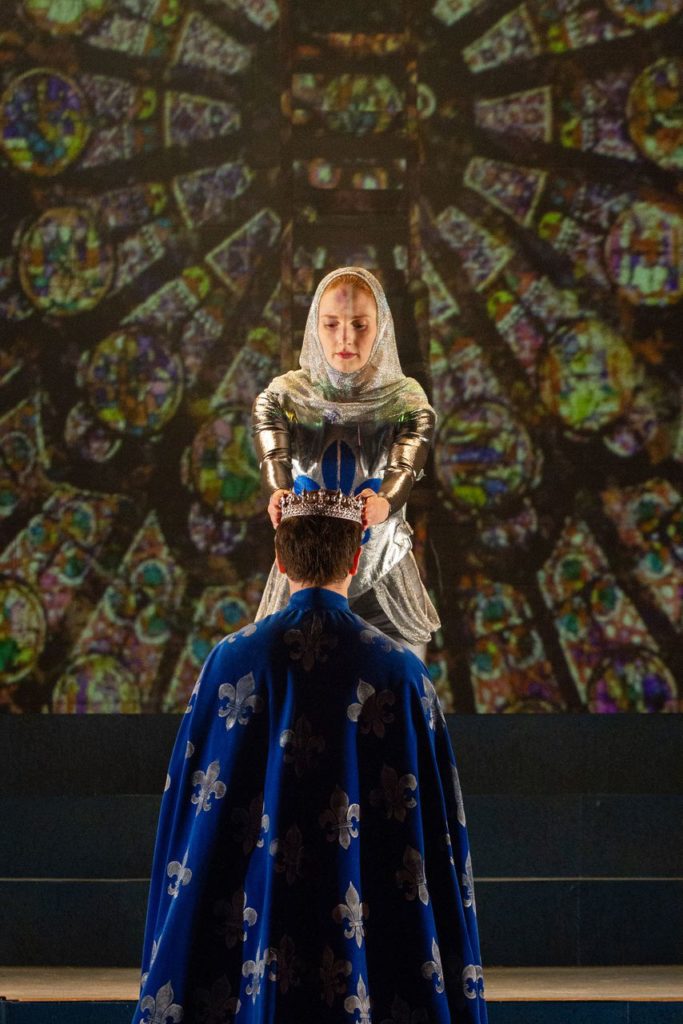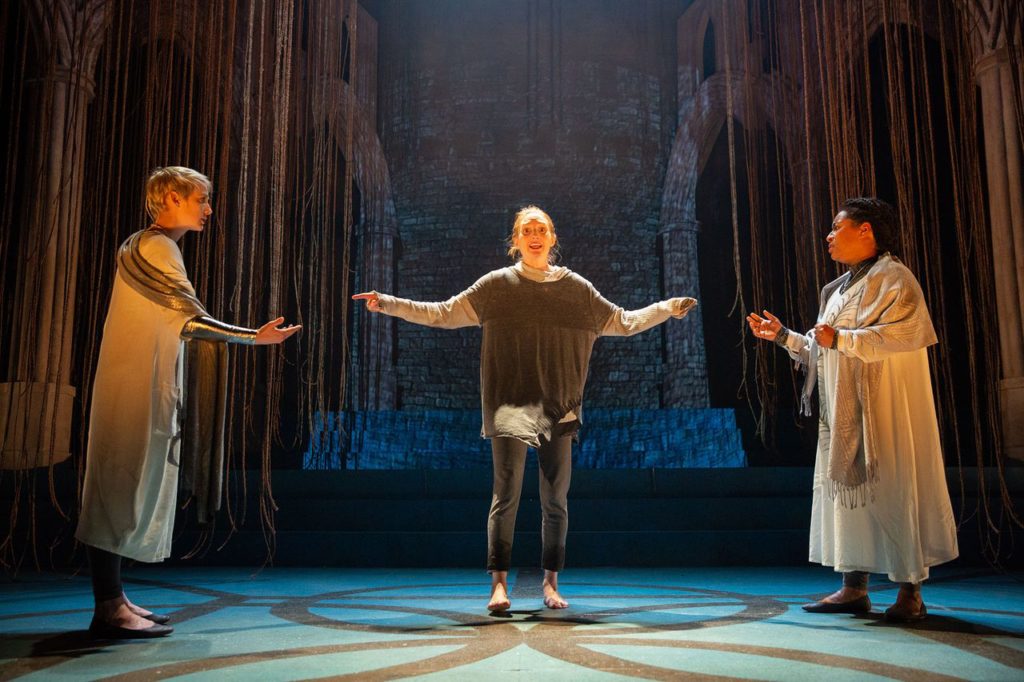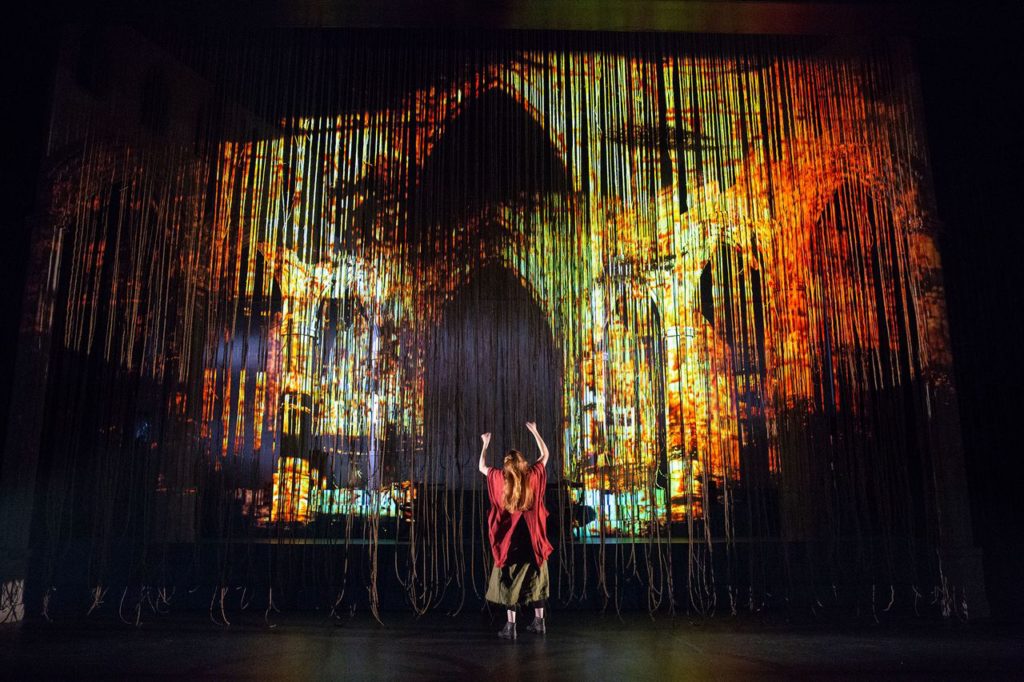by Betsy Price | February 8, 2019

Meet Joan of Arc.
Not the idealized hero who would become a Roman Catholic saint.
The Joan you will meet in a new Delaware Theatre Company production of George Bernard Shaw’s “St. Joan” comes complete with her doubts, her fears — and the two saints she claimed talked to her daily.
The new adaptation shifts the focus of Shaw’s play from a look at how men were affected by Joan’s actions to what theater is calling a fiercely feminist examination of what was happening with Joan herself.
Joan of Arc was a 15th-century French peasant teenager who claimed the archangel Michael and two saints told her to support Charles VII and throw off British domination in the Hundred Years’ War. She was eventually captured, turned over to the English and burned at the stake at the age of 19.
Executive director Bud Martin chose the play partly because he felt like it was a perfect fit for today’s world, where powerful women are bucking the status quo every day.
It’s also the 100-year anniversary of the 19th Amendment to the U.S. Constitution, which allowed women to vote, and comes in the wake of the Equal Rights Amendment being passed by the Delaware Legislature.
“Shaw’s version of the play has this very determined woman who has this singular purpose and a strong focus,” Martin says. “There’s a whole lot more underneath that we haven’t had a reason to look at.
“We look at her as a heroine,” he adds. “We haven’t looked at what kind of fear she may have had. What her doubts were. What her struggles were. Whether she even questions what she was.”

Upping the estrogen
Martin turned to playwright Chelsea Marcantel to adapt Shaw’s script. She has a sister who is a nun and has studied warrior saints.
“My first reaction, and Bud’s instinct as well, is how do we put Joan at the center of this play?” Marcantel says.
After reading works about Joan, watching documentaries and studying a biography based solely on the transcript of Joan’s inquisition, Marcantel’s version reduced the running time from three and one-half hours to a little over two hours.
The number of actors drops from 29 to eight, five of whom play multiple roles, increasing the theatricality of the show. She added women’s roles and some of the legends from Joan’s life, such as her knowing where to find Charlemagne’s sword, which had been buried secretly in a small church.
“The source that really helped me the most and the one I pulled the most from is her own words,” Marcantel says.
The result, she says, is a play that reflects the mix of people in everyone’s life.
“This story has a woman at its center,” she says. “Why should the rest of the people in it be men? There were women there. The saints played a huge role in her life. They visited her every day for five years.”
And in this adaptation, Martin says, “they have a lot to say.”
A sword-wielding Joan
Martin also wanted to do the play because he wanted to work with actress Clare O’Malley, who starred in the theater’s production of “Hetty Feather” and appeared in “Something Wicked This Way Comes.”
O’Malley, who was born in Ireland and is based in New York, was thrilled. It’s been a dream role for her since she was 10, she says, partly because all these things happened to Joan when she was just a teenager.
“How did you know?” she asked Martin when he called about whether she was interested in the role.
Joan doesn’t become a saint for hundreds of years, O’Malley points out.
“You can’t play a saint. You have to play a young person, a young girl, and that’s exciting to me,” she says. “Finding the real human in her.”
The role will be particularly physical for her, although that’s nothing new after having to learn circus acrobatics for “Hetty Feather.”
Shaw’s version of the play talked about Joan going off to war. Mercantel’s shows her fighting and being wounded in the throat. She continues fighting — one reason some thought she was a witch — and wins the day.
That means practicing, and lucky for O’Malley, husband Sean Michael Bradley is in the play and also is the production’s fight master.
“We practice with little knives in the kitchen at home,” she says, laughing. “One reason I love working with Bud Martin is because he always poses a challenge. Now I’m adept at sword-fighting.”

A set made of ropes
The show will play against Colin McIlvaine’s set, which uses arches and a sheet of rope created with 15,000 feet of rope. It was an idea he got after seeing an exhibit of fishing line in a cathedral. It lights beautifully and works well as a projection surface that allows the stage to morph instantly into different locations.
The show, as one might imagine from a story that ends in flames, isn’t all holier-than-thou.
Marcantel’s favorite scene comes toward the end when Joan is captured and imprisoned.
“She’s had it with the saints, and she kind of goes rogue,” O’Malley says. “It’s the only time she wavers and doesn’t go with the plan. It’s the only time I’ve seen it, so I’m glad we get to see that in his version.”
Ultimately, Marcantel says, she hopes the audience comes away inspired by the humanity of Joan of Arc “not because she was perfect or never doubted herself, but because she doubted herself and was constantly afraid, but kept getting up and doing it again.”
“St. Joan” is the first classic theater production Martin has done at Delaware Theatre Company, preferring more modern works. Subscribers have been asking for some, he says.
“If there’s a way to kind of create the epic nature of this play and give it a little more modern feel and tone, this might really work,” he says. “So far, it looks like it just might.”
If you go
WHAT: A new adaptation of George Bernard Shaw’s “St. Joan”
WHERE: Delaware Theatre Company, 200 Water St, Wilmington
WHEN: Through Feb. 24; opening night Saturday, Feb. 9
TICKETS: $25 to $62
FOR MORE INFO: Call (302) 594-1100 or go to DelawareTheatre.org
Click here to read the original article






